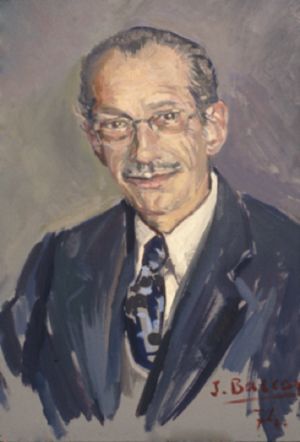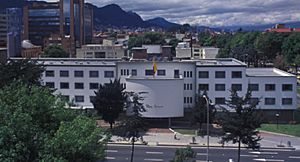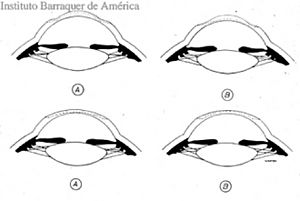Jose Barraquer facts for kids
Quick facts for kids
Excelentísimo Señor Don
José Barraquer
|
|
|---|---|
 |
|
| Born |
José Ignacio Barraquer Moner
24 January 1916 |
| Died | 13 February 1998 (aged 82) |
José Ignacio Barraquer Moner (born January 24, 1916 – died February 13, 1998) was a famous eye doctor (called an ophthalmologist) and inventor. He was born in Barcelona, Spain, but spent most of his life working in Bogotá, Colombia.
He was a pioneer in eye surgery, especially for fixing problems with the cornea, which is the clear front part of the eye. His work on corneal transplants and changing the eye's focus earned him the title "Father of modern Refractive Surgery." Many of his surgical methods and inventions are still used by eye doctors today.
Contents
A Life Dedicated to Eyesight
José Ignacio Barraquer was born in Barcelona. His father, Ignacio Barraquer, was also a well-known eye doctor. His grandfather, José Antonio Barraquer i Roviralta, was a pioneer of modern eye care in Spain. José's family had many famous doctors, including neurologists (brain and nerve doctors).
José's father taught him a lot about science and surgery from a young age. This helped José become a great inventor and surgeon. He studied medicine at the University of Barcelona and became an eye doctor under his father's guidance. He also visited other famous eye doctors across Europe to learn more.
In 1938, he married Margarita Coll Colomé. They had four children: Ignacio, Francisco, Margarita, and Carmen. Francisco and Carmen also became eye doctors.
In 1940, his family moved back to Barcelona. José worked with his father until 1953. Then, he moved to Bogotá, Colombia, to start his own work in eye care. He had traveled around South America, giving lectures and performing surgeries, and decided Bogotá was the right place.
In Colombia, he founded the Instituto Barraquer de América in 1964. He also opened his own eye clinic, Clínica Barraquer, in 1968. Later, in 1977, he started a special school for eye doctors within his institute.
In 1985, he married Inés Granados. They had a son, Jose Ignacio Barraquer Granados, who also became an eye doctor and works at the Clínica Barraquer.
Today, the Clinica Barraquer of America is a leading center for eye care and refractive surgery worldwide. José's children, Carmen Barraquer and Jose Ignacio Barraquer Granados, continue his important work.
Groundbreaking Research and Inventions
José Barraquer published his first article in 1942. In it, he showed his first eye surgery tool, the Barraquer Keratotome. This tool helped make very precise cuts during cataract surgery.
He published many articles in the years that followed. Some of his important early works included:
- Air injection in the anterior chamber in cataract surgery (1946)
- Refractive Keratoplasty (1949): This was his first article about how to fix myopia (nearsightedness) and hyperopia (farsightedness) by changing the shape of the cornea.
In Colombia, he kept working on corneal transplants, refractive keratoplasty, and lens surgery. He designed and built many new surgical tools. These included special hemostatic forceps (to stop bleeding), cataract scissors, and tools called trephines for corneal grafts. He also invented the "colibri blefarostat," a small tool for eye surgery.
He continued his research in his home lab. In 1958, he published about a "Method for cutting lamellar grafts in frozen corneas." This was a new way to approach refractive surgery. Between 1962 and 1964, he designed and built more precise surgical tools by hand. These included the microkeratome, which is a very important tool for eye surgery. He also improved a special "Lathe" machine to cut eye surfaces perfectly.
In 1964, he published about Keratomileusis for correcting myopia. This article described the microkeratome he invented. He also explained how to use it to reshape the cornea. In 1965, he published Foundations of Refractive Keratoplasty. This book explained all his research, findings, and the surgical methods of keratomileusis and keratophakia.
In this book, he explained "The Law of Thickness." This discovery became the main idea behind LASIK (Laser assisted Keratomileusis) and all other modern corneal refractive surgeries used around the world today.
In 1967, he worked with his brother Joaquin Barraquer Moner and a physicist to create a "new operating microscope for ocular surgery."
He wrote and published several books about his work. His first book, Keratomileuisis and Keratophakia (1980), described all his research on changing the cornea's focus. It included his findings, mathematical ideas, the tools he created, and the results of his surgeries.
His second book, Refractive Surgery of the Cornea (1989), was written with his daughter Carmen Barraquer-Coll. It updated his first book and also described other surgical methods developed by other eye doctors.
From 1977 to 1985, he taught refractive surgery courses at his institute in Bogotá. Over 100 eye doctors from all over the world came to learn from him. He also organized five big international meetings in Bogotá, where leading eye doctors from around the world gathered.
During his career, José Barraquer wrote 268 articles. He also invented 19 surgical techniques and 45 surgical instruments!
Awards and Honors
José Barraquer received many awards and honors for his amazing contributions to eye surgery:
- 1968 - Grand Honor Award for outstanding Achievements. Society of Cryo-Ophthalmology
- 1972 – Distinguished Service Prize Award for Excellency in Ophthalmology-Society of Contemporary Ophthalmology (U.S.A)
- 1976 – Gold Medal to the Microsurgeon of the Year. - World Microsurgery congress (U.S.A)
- 1982 – Karl Wessely Gold Medal- Augenerztliche Fortbildung (Germany)
- 1983 – José Ignacio Barraquer Moner Medal and Lecture – The International Society of Refractive Surgery (U.S.A)
- 1985 – Escudo Virgili- Facultad de Medicina de la Universidad de Cadiz (Spain)
- 1987 – First Albrecht von Graefe Award for distinguished contributions to Refractive Surgery.–The American Society of Contemporary Ophthalmology (U.S.A)
- 1987 – Medaglia D’Oro “ G.Cirincione” – Universita de la Sapienza di Roma (Italy)
- 1987 – Gold Medal Leonardo da Vinci – National Eye Research Foundation (Chicago – U.S.A)
- 1994 – Award “The ophthalmologist of the Century”. The International surgery Club (Montreal-Canada)
- 1998 – The Most Influential Ophthalmologists of the Twentieth Century.- The American Society of Cataract and Refractive Surgery (Seattle- U.S.A)
Decorations
He also received many special decorations from governments and organizations:
- 1968 – Commander of the Order of San Carlos (Colombia)
- 1968 – Commander with Plaque of the Civil Order of Alfonso X, the Wise (Spain)
- 1976 – Silver Medal of Merit in Labour – Ministry of Labour (Spain)
- 1977 – Caballero de Honor y Mérito de la Orden de Malta (priorato de U.S.A)
- 1980 - Commander of the Order of Boyaca (Colombia)
- 1983 – Gran Cruz de San Jorge y Constantino el Grande - Orden Constantiniana de San Jorge (Colombia)
- 1984 – Grand Officer of the Order of Boyaca (Colombia)
- 1995 - Grand Cross of the Civil Order of Alfonso X, the Wise (Spain)
Academic Distinctions
Universities and academies also honored him with special titles:
- 1961-1973 - Visiting professor of Ophthalmology – Baylor University, College of Medicine, (Houston, U.S.A)
- 1967 – Académico de Honor de la Real Academia de Medicina de Murcia (Spain)
- 1969 – Awarded title of doctor honoris causa by the Federal University of Santa Maria (Brasil)
- 1970 – Miembro de Mérito de la Academia de Ciencias Médicas de Barcelona (Spain)
- 1975 - Honorary Professor in the National University of San Marcos (Perú)
- 1987 – Awarded title of doctor honoris causa by the University of Cádiz (Spain)
- 1990 – Awarded title of doctor honoris causa in ophthalmology by the University of Cartagena(Colombia)
See also
 In Spanish: José Barraquer para niños
In Spanish: José Barraquer para niños




